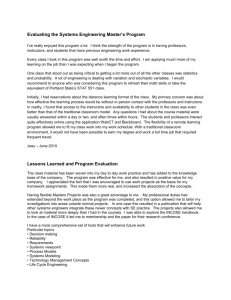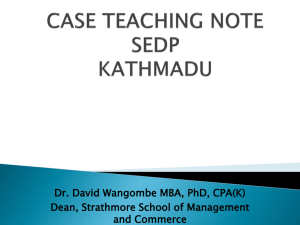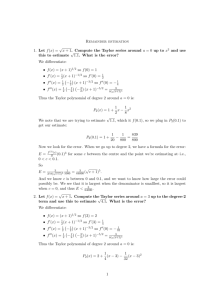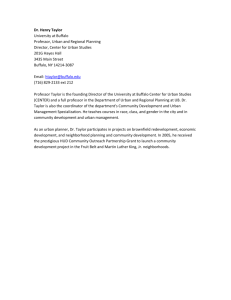Democracy - Furture of Higher Education
advertisement
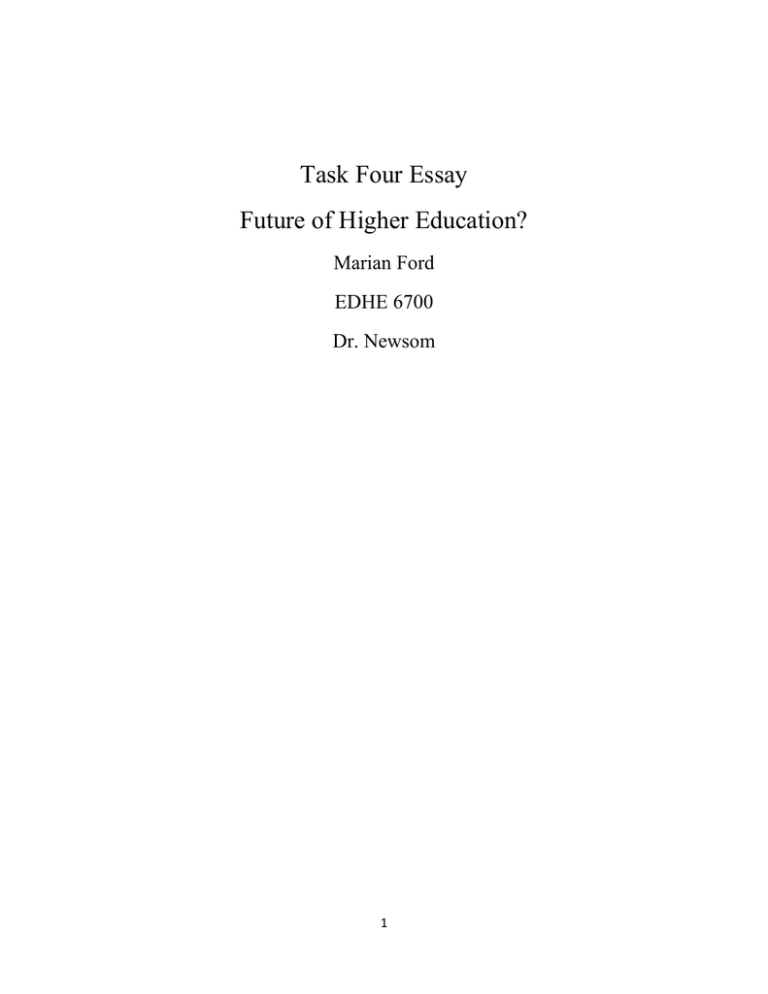
Task Four Essay Future of Higher Education? Marian Ford EDHE 6700 Dr. Newsom 1 What is the Future of Higher Education? There are many trends and issues that will impact the future of higher education. The characteristics and demands of students in higher education are constantly evolving and before institutions establish any new policies or practices or future changes, they need to identify the population of students that they will be serving in the coming decades in order to evolve with the needs of society. Institutions need to seek the best interests of their individual students for the betterment of the entire society; and through education, experience and knowledge institutions help members of a society make better choices. By utilizing resources such as the emergence of technology and recognizing the increasing need and technical knowledge base of the American population in our institutions we can better understand how college affects our students. The impact of technology, out of class learning, the effectiveness of online learning and competition for the new majorities of students are some of the emerging issues. Research and data about existing college students helps provide insight into the intellectual and social growth of students, but in order to help predict future trends we should investigate the new generation of college students and how their demands will impact research, practice and policy. Our society is constantly developing and so then must our colleges and universities adapt to the changing external environment through policy, instruction, service and research. A postsecondary education is no longer a place for the elite who could afford the luxury of higher education after graduating high school but also a desire and necessity for many American citizens and industries. Institutions have to evolve with 2 society’s demands and change in order to attract and retain students because competition for students is fierce. A college degree has become a necessity for most careers according to President James Duderstadt of The University of Michigan (Duderstadt, 2005). The expansion of technology is a trend that has greatly impacted higher education’s operation, mission and public policy in the 21st century. The use of technology is convenient for students but is creates a challenge for institutions and its faculty and administration regarding finances, feasibility and training. Online programs have expanded where popular universities (such as Devry Institute and Phoenix University) offer entire online degree programs. It is possible with the future of higher education that a student can graduate from a traditional institution without ever setting foot in the institution and meeting their professors? Distance learning aims to deliver education to students who are not physically “on site”. Instead of attending courses in person, professors and students can communicate at times that are convenient to them through printed or electronic media 24 hours a day 7 days a week. Competition now exists between colleges that didn’t previously compete such as with the University of Phoenix and some community colleges with online degrees. According to the National Center for Education Statistics, distance education has become increasingly common in postsecondary education. In 2004-2005, 62 percent of public and private not for profit two and four year institutions offered distance education courses as reported to the Center. A minority of faculty served, however, appear to teach the distant learning courses. Eight percent of full time and six percent of part time instructional faculty and staff reported teaching a distance education course in the fall of 3 2003. With the increasing demand and evolution of technology in higher education, what is to come of the socialization exhibited within the classroom? Many will argue that technology isolates people and online learning will only add to the problem. Traditional undergraduate students do not just attend college to obtain knowledge about their future career; they also learn social skills and how to integrate into society. This balance remains critical in preparing research and establishing policies and procedures for the future learning in higher education. As each generation evolves, technology and media seem to decrease the human connection. Currently, we are seeing the evolution of what researcher, Dr. Mark Taylor, calls “Generation NeXt” (Taylor, 2008). The evolution of technology has made it easier for students to become less involved in student activities on campus. The typical classroom is no longer limited to four walls and set hours. The Internet allows learning to be facilitated at any location at any time. As colleges and universities see their budgets reduced, institutions of higher education are attempting to increase their enrollment without constructing physical classrooms. The initial online boom was in the early 1990s when traditional colleges depended on the Internet as a vehicle to deliver their courses. (Peterson, 2006) Slowly, higher educational institutions recognized that people of all ages were willing to pay for the convenience and flexibility of learning online. Carol Scarafiotti, Vice President Emertius of Ro Salado College writes, “The Digital Natives, Gen Xers, and the Net Generation students in the classroom will push online learning and force us to do a better job. They won’t be tolerant of text-based learning. They will want highly interactive classes. Gen Xers like online education, but the NetGen demands it” (Peterson, 92). 4 Traditional four year students who live on campus might become a rarity. There are increased rates of commuter students and students opting to remain at home because there is no longer that sense of urgency to move out. Students are working part time and attending school when they can fit it into their schedule. They do not have time to become involved in school activities; they are working, taking care of families and attending classes (Taylor, 2005). The fast paced world that has been created has caused the attention span of students to wane. Students do not have the time to attend class on campus and listen to professors when they can research on their own and be self taught with the many online classes. Online learners are a diverse group which varies in age, occupation, background, interests, and computer proficiency. Examples of online users include but are not limited to working adults, retired adults, those in the military, and those with a disability. Dr. Mark Taylor is an educator and consultant with 25 years of experience in higher education. He has a doctorate in Counseling and provides research and programs to help improve educational services to the current generation of college students and helps provide data, perspectives and suggestions to college and universities as well as business and organizations. Dr. Taylor presents the idea that the college aged student of today is different from the previous generations of college students. By helping understand the differences schools can respond effectively in bringing meaningful learning and developmental outcomes, improved services and instruction as well as provide business with the ability to better manage successfully younger workers. Differences in goals with respect to learning are apparent, and a serious issue remains between the initiatives that need to be in place for this new generation to 5 succeed. According to the Department of Education, 45 percent of students that seek bachelor degrees fail to earn degrees in six years and 70 percent of two year associate students fail to do so in less than three years. Major gaps remain between the technology omnipresence of the lives of students and the realities of institutional services, especially learning services. Schools need to embrace technology and leverage it for academic and developmental means and ends rather than complaining (Delfino and Persico, 2007). Youth have little patience for educational methods that they see as outdated like the unidirectional lecturing to rows of passive listeners. Instructors that cannot utilize technology might be viewed by students as less educated in their field than as those instructors using technology. Students want to have faith in the school that they attend. "NeXters” are wired since birth and are impatient with those that lack technological sophistication. “Concerns about the slow adoption of technology by teachers are not new” (Zhao and Frank, 2003). Higher education should be the most progressive, databased and outcomes orientated of all the social institutions that exist around the world, but they are often the most resistant to change (Taylor, 2008). Institutions need to maintain technological sophistication, because upcoming generations do not have patience for anything outdated (such as emails as opposed to text messages). They want increased flexibility in course schedules, semesters, and entry and exit. Students are juggling other responsibilities and are learning at different paces. The experience of being in a campus environment has already become too expensive for most students. Instructional technology has held the most allure for them. Money can be saved through use of distance education courses delivered to remote locations. Students demand not only technologies in the classroom with technological 6 savvy instructors but also professors who can teach effectively online. This is a particular demand for students who are in “development” courses. The demand for effective online instruction is an area that needs to be addressed because the move to more online courses will affect the majority of students who have academic deficiencies. Multimedia classrooms have allowed instructors to computerize their presentations of material and Internet-based resources are becoming more vital with electronic discussion and Web-based applications (Koeber, 2005). Technology changes constantly and it can be difficult for instructors and institutions to stay current with new developments (Zhao & Frank, 2003) but critical for students’ success and confidence in the future of higher education. ITunes University is a website sponsored by Apple Computers that has downloadable educational podcasts that provides students the ability to listen to lectures when they are not able to physically attend their classes. The podcasts are available 24 hours a day for students and “engages them in a way that is very familiar to them” (McKinney, 617). Through the evolution of technology students can now learn outside of the traditional classroom with stand-alone web-based courses. Computer based lectures appeal to the flexibility of the students of today and the future. An important aspect of technology is how to incorporate new technology into the classroom setting so that technology will enhance student’s learning without eliminating the professor and student relationship. With the pressure to stem the rising costs of higher education and fewer faculty because of budget cuts, the possibility of less interaction between instructors and students has become a reality but the relationship is one that should not be completely annihilated. 7 Higher education institutions need to embrace trends such as the emergence of technology, out of class learning, the effectiveness of online learning and competition for the new majorities of students in order to evolve with their target students today and in the future. If institution starts competing just to confer degrees based on accumulating credits (online, reduced time delivery methods, etc.) will a college degree mean the same as it did in the past? If we are just awarding credits, then why have any traditional colleges? Research can be done to demonstrate the psycho social and intellectual development of our students to ensure they are maintaining the faculty and peer relationship vital to a successful college experience and tenure is coupled with the emerging trends of new technologies and changing profiles of our current and future students. So what are the probable changes we can foresee for higher education regarding technology and student interaction as we navigate our way through the new millennium? With the constant ever expanding world of technology and the fast paced environment, higher education must meet the needs of its students. The new brand of student is technologically versed with a sense of urgency and efficiency. Students have busy lives and school is just one of their priorities. They want fast, efficient and effective service from administration and from the faculty. The experience of a campus environment might be too expensive, inflexible, and unnecessary for upcoming generations. The advance of technology as well as the pace of the fast moving new generation has been the catalyst for the distance education demand. The correct use of technologies allows for more data and more recent information, and it saves valuable time by providing materials online. The evolution of society has seen the need and demand for online education 8 because of the evolution of technology; higher education must provide these services in order to remain in the hunt for a revolutionized generation of students. It is critical for the development and integration of technology to become dominant in the future processes and policy making in higher education in order to contribute successful, educated and intellectually grounded individuals into society. 9 References 1. Delfino, M., & Persico, D. (2007). Online or face-to face? Experimenting with different techniques in teacher training. Journal of Computer Assisted Learning. 23, 351-365 2. Duderstadt, James (March 8, 2005). The Future of the University: A Perspective from the Oort Cloud. Emory University Futures Forum, Retrieved March 8, 2009. 3. Koeber, Charles (2005). Introducing Multimedia Presentations and a Course Website to an Introductory Sociology Course: How Technology Affects Student Perceptions of Teaching Effectiveness. Teaching Sociology. 33, 285-300. 4. McKinney, Dani (2009). ITunes University and the classroom: Can podcasts replace Professors? Computers & Education. 52, 617-623. 5. Thomas Peterson (2006). Peterson (1st ed.) [Brochure]. Canada: 6. Rotem, Abrham, and Oster-Levinz, Anat. 2007. The School Website as a Virtual Learning Environment. The Turkish Online Journal of Educational Technology, 6,1-5. 7. Taylor, Mark (2005). Generation NeXt: Today's Postmodern Student-Meeting, Teaching and Serving. A Collection of papers on self-study and institutional improvement, 2, Retrieved 2-25-09, from http://www.taylorprograms.org/drtaylorarticles. 8. Taylor, Mark (2008). Meet the Students: Finding Common Ground between Student and Institutional Goals. 9. Zhao, Yong and Frank, Kenneth (2003). Factors Affecting Technology Uses in Schools: An Ecological Perspective. American Educational Research Journal. 40, 807-840. 10 11
